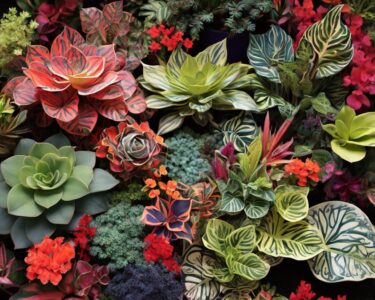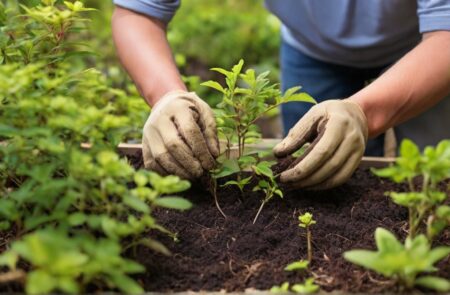- Introduction
- Create compost as organic fertilizer
- Bokashi: Efficient method for fertilizer production
- Making nettle slurry as a liquid fertilizer
- Use coffee grounds and eggshells as fertilizer
- Mulching with organic materials
- Summary and conclusion
1. introduction
In a world where sustainability is becoming increasingly important, the importance of organic fertilizers is also coming more into focus. The use of organic fertilizers is not only a step towards a more environmentally friendly garden, but also promotes healthy plant growth and improves soil fertility in a natural way. With the right approach, your garden will become a source of sustainability and vitality. Organic fertilizer, made from everyday waste products such as coffee grounds and eggshells or from special ingredients such as algae and horn meal, is a powerful garden helper that also protects the environment
In this article, you will discover how you can make the best organic fertilizer yourself. From creating your own compost as a soil activator to the efficient bokashi process and the use of nettle manure and other organic materials - we show you step by step how versatile organic fertilizer can be. Use coffee grounds, eggshells and other natural resources not only as fertilizer, but also as soil conditioners to take your plant growth to the next level. In short, this article will provide you with all the tips and tricks you need to transform your garden into a healthy and thriving ecosystem with homemade organic fertilizer.
2. create compost as organic fertilizer
Advantages of compost
Compost offers numerous benefits for your garden and the environment. It improves plant growth and health by providing nutrients in a stable organic form. This promotes deeper root development and improves the physical, biological and chemical properties of the soil. Compost also reduces erosion, conserves water and helps to minimize weed germination. It also helps to reduce greenhouse gas emissions and promotes carbon sequestration in the soil, which contributes to climate change adaptation.
The basics: what belongs in and what doesn't
To create an effective compost heap, it is important to know which materials should be added and which should be avoided. "Green" materials include kitchen waste such as fruit and vegetable scraps, coffee grounds and tar residue. "Brown" materials include things like straw, paper and dry leaves. Avoid adding meat, bones, dairy products and greasy foods as these can attract pests and cause unpleasant odors. Sick plants and weeds with seeds should also be avoided.
The process: From kitchen waste to nutrient-rich compost
The composting process begins by selecting a suitable location in your garden that is well drained and receives partial sunlight. Start your compost pile with a layer of twigs or old mulch to promote air circulation. Then alternate layers of your green and brown materials. After each layer, add water to maintain moisture, but make sure the pile doesn't get too wet. A final layer of soil or finished compost will help reduce odors. Regularly turning the compost with a fork or inserting aeration tubes will provide the necessary oxygen supply and speed up the decomposition process. The compost is ready to use when it has a rich brown color and crumbles easily.

3. bokashi: efficient method of fertilizer production
What is Bokashi?
Bokashi is a Japanese method of fermenting organic waste, which allows for quick and efficient conversion into nutrient-rich fertilizer. The term "bokashi" means "fermented organic matter" and refers to both the method and the inoculum, a mixture of microorganisms that drive the fermentation process. This mixture consists of lactic acid bacteria, photosynthetic bacteria and yeast embedded in a carrier material such as bran or sawdust.
The advantages of bokashi compared to traditional compost
Bokashi offers several advantages over traditional composting methods. It is an anaerobic process that takes place in a closed container without the addition of oxygen, thus avoiding unpleasant odors. In addition, Bokashi is able to process not only plant waste, but also meat, cheese and egg products without promoting pathogenic germs such as salmonella or E. coli. Another significant advantage is the speed of composting; within just 10 to 12 days, Bokashi can convert organic waste into a rich, microbial fertilizer.
Instructions: How to create your own bokashi fertilizer
- Prepare materialsYou will need a bokashi bucket with an airtight lid, bokashi bran (fermented bran) and your organic kitchen waste.
- Start layeringPut a layer of waste in the bucket and sprinkle a handful of Bokashi Bran on top. Repeat this process until the bucket is full.
- FermentationSeal the bucket and leave it in a cool, dark place for about two weeks. During this time, you should drain the sap that forms every few days.
- CompletionAfter fermentation, the material is ready to be incorporated into the soil. Dig a hole and mix the bokashi with the soil to promote final decomposition.
By using this method, you can not only effectively recycle your organic kitchen waste, but also significantly improve the soil health of your garden.
4. make nettle slurry as a liquid fertilizer
Benefits of nettle slurry
Nettle manure is an excellent organic fertilizer, rich in nitrogen, chlorophyll and important minerals such as magnesium, sulphur, iron, potassium, copper, zinc and calcium. These nutrients are essential for plant growth, strengthen the plants' immune system and help them to better resist diseases and pests. In addition, nettle manure is a natural activator for compost, as it accelerates the decomposition process.
Step-by-step instructions for production
- Collect netsChoose a location where stinging nettles are abundant. Wear thick gloves and long-sleeved clothing to protect yourself from the stinging hairs.
- Shredding the nettelnCut or chop the netteln into small pieces. This increases the surface area and speeds up the fermentation process.
- Inserting the nettingFill a bucket or large tub with the chopped netteln. Weigh down the netteln with a stone or brick to keep them under water.
- Water additionFill the container with rainwater, as this is free from chlorine and other chemicals. Leave some space at the top of the container to allow foaming during fermentation.
- Fermentation processCover the container and place it in a semi-sunny spot. Leave the mixture to ferment for 1 to 3 weeks, stirring every few days.
- CompletionAfter fermentation is complete and no more bubbles are formed, filter the liquid through a coarse cloth.
Application tips for effective results
- DilutionDilute the nettle slurry in a ratio of 1:10 with water for root irrigation or 1:20 for foliar application. For foliar application, add half a teaspoon of liquid soap per 4 liters to improve adhesion to the leaves.
- FrequencyApply the diluted nettle slurry every three weeks during the growth phase.
- CautionAvoid using on plants that are sensitive to high levels of iron, such as tomatoes and roses. Start with low concentrations to test tolerance.
- Compost activatorUndiluted nettle slurry can be added directly to your compost heap to speed up the decomposition process.
This natural and cost-effective method of fertilizer production uses the full potential of nettles and supports sustainable, environmentally friendly horticulture.
5. use coffee grounds and eggshells as fertilizer
The benefits of coffee grounds as fertilizer
Coffee grounds are an excellent source of nitrogen, an essential nutrient that promotes plant growth. After you have enjoyed your coffee, the leftover coffee grounds can provide valuable services in your garden. They also contain potassium and phosphorus as well as important micronutrients such as magnesium and copper. These nutrients support the health of your plants and improve soil structure by promoting drainage and water retention.
- Nitrogen releaseCoffee grounds release nitrogen, which serves as a growth booster for plants.
- Soil structure improvementIt improves the soil structure, which leads to better aeration and water retention.
- Pest defenseCoffee grounds can help ward off pests such as snails and ants.
Using eggshells correctly for soil improvement
Eggshells are rich in calcium carbonate, which provides the soil with vital calcium and can regulate soil acidity. Calcium is crucial for the development of strong cell walls in plants and can help prevent problems such as blossom end rot in tomatoes.
- Calcium intakeThey provide a constant source of calcium, which is essential for plant development.
- Soil pH regulationEggshells help to balance the pH value of the soil, especially if your garden soil is too acidic.
- Pest controlCrushed eggshells can serve as a natural barrier against slugs and other pests.
Application tips for optimum plant growth
To reap the full benefits of coffee grounds and eggshells, it's important to use them correctly. Here are some tips on how to use these natural resources effectively in your garden:
- Using coffee grounds correctly:
- Allow the coffee grounds to dry first to prevent mold from forming.
- Mix the dried coffee grounds directly into the soil or sprinkle them around the base of your plants.
- Use coffee grounds sparingly to avoid compacting the soil, which could hinder aeration.
- Using eggshells effectively:
- Wash and dry the eggshells to eliminate the risk of salmonella.
- Grind the dried peel into a fine powder to accelerate the release of calcium.
- Sprinkle the eggshell powder directly into the soil or add it to your compost to increase the calcium content.
By combining these natural materials, you can not only improve soil quality, but also create a sustainable source of nutrients for your plants that promotes their growth and health.
6. mulching with organic materials
Mulching is a common gardening technique that improves soil conditions and promotes plant health. It involves covering the soil with mulching materials such as bark, wood chips, leaves and other organic matter to retain moisture and improve the condition of the soil. This technique is not only efficient and practical, but also cost-effective considering its many benefits.
What is mulching?
Mulching refers to covering the soil with loose coverings or layers of material to keep the soil moist, suppress weed growth and improve the soil around plants. Mulching materials can be applied to bare soil or to cover the surface of compost in containers. There are many types of mulch, but organic mulches are particularly beneficial as they release nutrients into the soil as they decompose.
Effects of mulching on soil and plants
Mulching offers numerous benefits for the garden. It helps the soil retain moisture, reduces the need for watering, suppresses weeds, improves soil organic matter, provides nutrients, protects plant roots from temperature extremes and encourages beneficial soil organisms. Biodegradable mulches gradually decompose to release nutrients into the soil and improve its structure. The best materials include garden compost, wood chips, processed conifer bark, leaf mold, well-rotted manure, straw (for strawberries), excavated hops and seaweed.
Instructions: How to mulch your bed correctly
- Prepare the floorRemove weeds and loosen the soil slightly to create a good base for the mulch.
- Select mulch materialOpt for organic mulch materials such as garden compost, wood chips or leaf mold, which release nutrients into the soil as they decompose.
- Spreading mulchSpread the mulch evenly over the prepared soil. Make sure to achieve a layer thickness of at least 5 cm (2 inches) and ideally 7.5 cm (3 inches).
- Keep your distance from plantsLeave at least 1 inch of space between the mulch and the growing stems to prevent rot.
- Renew mulchAs organic mulch decomposes over time, it should be renewed or replenished regularly to maintain its benefits.
Organic mulches are a simple and effective way to boost the health and vitality of your garden. By following these steps, you can not only improve soil quality, but also create a sustainable source of nutrients for your plants.
7 Summary and conclusion
By using the methods presented here to make organic fertilizer, you not only contribute to a healthy and thriving garden, but also support sustainable gardening practices. Whether by composting kitchen scraps, using bokashi to speed up the fermentation process, making nettle slurry as a liquid fertilizer, or using coffee grounds and eggshells as a nutrient source, each of these techniques promotes the vitality of your garden in an ecologically responsible way. These practices improve soil quality, promote plant growth and increase plant resistance to disease and pests.
For gardeners who want to design their practice in harmony with the environment, these techniques offer valuable insights and methods to improve soil fertility and cultivate healthy plants. By making the most of these natural resources, you not only help to protect the environment, but also ensure the enjoyment of a lush and vibrant garden. The methods presented are clear proof that sustainable gardening is both practicable and beneficial for the environment and garden quality. It is therefore worth exploring these organic fertilization methods and integrating them into your own gardening practices to promote a healthy balance in your garden's ecosystem in the long term.
Further questions and answers about organic fertilizers
What is considered the most effective natural fertilizer for garden plants?
Compost is one of the best and most nutrient-rich natural fertilizers. In the compost heap, microorganisms decompose materials such as leaves, grass clippings and vegetable waste, creating a nutrient-rich fertilizer.
Which organic fertilizers are best for the garden?
The top organic fertilizers include:
- floraPell Organic fertilizer
- Neudorff BioTrissol flower fertilizer
- Cuxin DCM Myko-Active
- KleePura The organic fertilizer
- Niem-Handel Humeen-Niem fertilizer
- Oscorna Animalin garden fertilizer
- BioBizz Bio Grow
- Organicus The garden fertilizer.
How can I make my own flower fertilizer?
To make your own fertilizer, mix 1 liter of water with 3-4 crushed eggshells. Leave the mixture to stand for a week so that the water can absorb the nutrients from the shells. You can then use this fertilizer to water your plants.
How do you prepare organic fertilizer at home?
Answer: To make your own organic fertilizer, ferment around one kilogram of green plants such as comfrey, lungwort or nettles in ten liters of water for two to three weeks. After straining, dilute the liquid with ten parts water and use this mixture to water your plants every week.

















